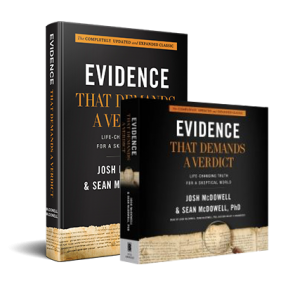
Historical Documentation Resoundingly Says, “Yes!”
In a previous blog post in this series, we saw that the New Testament can rightly claim to be more reliable and accurate than another other ancient document in history. Can we also trust the authenticity of the Old Testament?
Fortunately, we have really old biblical manuscripts to help us answer that. Too, we have documented proof of how meticulously Jewish scribes — even long before Jesus — faithfully transmitted and preserved these biblical texts.
First, the Back Story
We forget that the Bible did not come to us as one book. Rather, Scripture is a collection of books, written primarily in Hebrew, over a span of more than a thousand years. We can list among the authors of the Old Testament kings, prophets, generals, and even shepherds. Included genres — categories of writing — range from history, narrative, poetry, wisdom, lament, and apocalyptic literature.
It would be so much neater, when trying to answer the question, “Are we reading the Bible God intended?” if each book of the Hebrew Bible (the Old Testament) came into existence at one time, and if each book was considered complete at the time it was composed. Evidence, however, suggests this was not always the case.
The Dead Sea Scrolls, just one of five important Hebrew manuscripts that we’ll look at in next week’s blog post, are fragments of the oldest known Hebrew Bible text. Fragments aren’t enough to go on. So modern scholars point us to the Aleppo Codex and the Leningrad Codex (housed in the National Library of Russia), written in the 10th and 11th centuries by scribes called the Masoretes, as authoritative copies of the Hebrew Bible.
The Leningrad Codex has been used as the basis for most modern printed editions of the Hebrew Bible. Comparing it to modern Hebrew Old Testaments shows us just how accurately God’s Word has been preserved over the centuries.
The Bible Manuscript Society puts it this way: the Leningrad Codex provides irrefutable proof that the Hebrew Old Testament has remained unchanged down through more than one thousand years, copied faithfully from manuscripts one thousand years earlier.
It adds:
Think about the implications of that for a moment. Down through more than two thousand years, though world empires have come and gone, across cities, counties and continents, the Hebrew Old Testament has been miraculously and meticulously preserved. Wars have ravished. Cities have been plundered. Rulers have come and gone. Empires have long since arisen, died and disappeared into the history books. Yet amazingly, miraculously, the Hebrew Old Testament has been preserved intact down through all those intervening centuries, remaining as free from corruption and variation as mortal man is capable of.
Scribes Faithfully Transcribed
Old Testament scripture itself doesn’t give us a clear idea of when the books were assembled into the Bible we use today. But scholars believe the Old Testament canon was closed earlier than 200 BC. Too, they believe the earliest biblical manuscripts were transmitted in the oral tradition. At some point, however, it was deemed critical that Scripture be written down to ensure its accuracy.
The Scriptures were so important to the nation of Israel, that a special class of scholars called Soferim (Hebrew: סוֹפְרִים) developed during the Second Temple period. From about 500 BC to 100 AD, the primary task of these scribes was to preserve Israel’s sacred traditions, which served as the foundation of the Jewish nation.
Scholars believe these Jewish men were possibly of priestly descent, as most sofer whose geneology is known were priests. As such, the Soferim were intimately acquainted with Scripture and other sacred documents. They likely specialized in the biblical manuscripts they transcribed and the topics they wrote about.
As noted in the Encyclopedia Britannica:
Historically, the Soferim are of great importance, not only for having initiated rabbinic studies but also for having fixed the canon of Old Testament Scriptures and, as copyists and editors, for their energetic efforts to safeguard the purity of the original text. The Talmud (the collection of traditions on Jewish religious laws) records 18 changes (tiqqune soferim) that they introduced to preclude misunderstanding of the Scriptures.
The Soferim were followed by a second group of scribes called Tannaim (Hebrew: תנאים), “repeaters” who began copying the Soferim tradition. From about 200 to 500 AD, a third group of scribes called the Amoraim began to preserve Hebrew text. At some point in this period, meticulous rules were developed to preserve Old Testament text in the synagogue scrolls.
Finally, about the 8th century AD, we come to the group of scribes, the Masoretes, which we mentioned earlier. Their diligent efforts help to preserve the Hebrew text we have today, which is called the Masoretic Text. The Masoretic Text is a very good and faithful text of the Hebrew Bible, yet not perfect.
The Masoretes, themselves, recognized the inherent possibility of human error when copying the Hebrew Bible. They attempted to combat errors by adding innumerable notes — masorah — in the margins of manuscripts to safeguard the text. Where they found differences between texts, they determined which opinion was correct.
These decisions related not only to verses and words, but to every single letter. Too, these scribes attempted to gain consistency by establishing rules on how to articulate the words when reading the text aloud. We know the proper pronunciation because of the system of chanting symbols and vowel placement established by the Masoretes.
Explains the Encyclopedia Britannica:
If the Masoretes hadn’t devised their systems of vowel notation, the most important Hebrew texts would have been translated and possibly preserved but the rest of it, as well as the Hebrew language at large, would have gone the way of the dodo. We wouldn’t have had the Bible as we know it, if it wasn’t for the Masoretic efforts.
Establishing Transmission Standards
When you’re copying the Word of God, standardization becomes an important consideration.
We know that various rabbinic rules — including the selection of writing materials, the preparation of leather (parchment), error correction, transcribing of divine names, the storage and reading of scrolls, and measurements of sheets, columns, and margins — all point to the reverence that rabbinic scribes had for biblical text.
Again, the scribes revered Scripture so highly that, through the ages, they took meticulous care in their work. One example: scribes may have known their biblical texts from memory, but they were forbidden from copying Scripture without a vorlage (the manuscript being copied) in front of them. While this did not ensure a flawless transmission of the text, it did provide a structural safeguard.
Paul D. Wegner, professor of Old Testament studies at Gateway Seminary in Ontario, California, shares further safeguards and protocols that aided scribes in their copying and storage of biblical texts:
~ Jewish writings mention that the temple employed correctors (meggihim) who scrutinized the scrolls to safeguard their precision.
~ At some point during the talmudic period (100 BC to AD 400), meticulous rules were developed to preserve the Old Testament text in synagogue scrolls. These included only using parchment made from clean animals, using only black ink, lining the page before adding letters, and establishing a set column width and word spacing (the space of a hair between each consonant, and the space of a consonant between each word). Too, the scribe had to be freshly bathed and in full Jewish dress before beginning to copy the scroll.
Writes Wagner, in an article titled “How Did We Get the Old Testament?“ for Credo Magazine:
“These scribes made meticulous notes regarding the text, from recording the number of letters used in a book, to indicating the middle letter of a book. They also made careful notations along the sides of the Hebrew text in multiple other volumes concerning the reading and pointing of these texts.”
Later, an entire treatise was created to guide scribes on the proper procedure for preparing a sacred scroll and producing an accurate text. It seems that the various communities of scribes began to unify at the end of the first century AD. This ultimately led to a standardization of authoritative biblical text that, albeit not intentionally orchestrated, was an inevitable result of historical circumstances.
Materials and Equipment Used by Scribes
Scholars can ascertain, with a high degree of confidence, which materials and equipment these ancient scribes used to faithfully transmit the biblical narratives.
They used pens and ink, though not the ballpoints that you and I are familiar with. These scribes used inks typically compounded from charcoal, gum, and water. Typically, their pens were fashioned from reeds and quills. As these scribes also lacked the processed pulp that our paper is made with today, they used what was on hand to record writings: papyrus (water reeds), parchment (animal skins), broken pottery, and wooden tablets. Our earlier blog post dives into writing materials much deeper.
Archeologists have even discovered proof that copper was used, at least once, by an ancient scribe as a writing surface. The Copper Scroll found in a cave at Qumran, in Israel, is made from thin sheets of copper. When discovered by archeologists, the heavily oxidized manuscript was far too brittle to unroll. It took scholars a while to devise a tactic for examining the ancient text. (Archeology sounds like a really cool career, right?) After the text of the scroll was translated, the world learned that it was basically a treasure map. Its listed treasures, as of yet, have remained unfound.
The Leningrad Codex, mentioned earlier, is called a “codex” because it is in book form, rather than a scroll. Scrolls were very heavy, if large, which made them difficult to handle. The codex format is easier to read, protect, and store.
Historic Texts Validate the Bible’s Old Testament
Clearly, many hands have been involved in the creation of the books included in the Old Testament. Human error, specific to mistakes made in the act of physically adding ink to scroll, have been made. But they also have been diligently chased by scribes committed to authenticity.
With more than 300 ancient Hebrew manuscripts now available to scholars for review and study, and new biblical manuscripts continually being discovered, scholars remain unwavering in their belief that the Old Testament, which you and I have the luxury of perusing any time we decide to open our Bible, is God’s Word.
So the next time you hear someone say that the Bible is a bunch of books that “someone threw together” that “can’t be vetted for accuracy” and “couldn’t possibly be correct in its entirety,” you’ll have some proven facts to share with them. But let’s keep going! There’s so much more to learn about this amazing book God gave us!
Next week, together we’ll look at five ancient Hebrew and non-Hebrew biblical manuscripts — the Masoretic Text, the Dead Sea Scrolls, the Samaritan Pentateuch, the Nash Papyrus, and the Silver Amulets — which have survived, in large part, because of the meticulous care of dedicated scribes over the centuries. Thanks, Dudes. You did well!

This blog post highlights Josh and Sean McDowell’s recently revised apologetics classic, Evidence That Demands a Verdict. We are certain this fully updated and expanded resource will be an effective evangelism tool for you, and strengthen your faith by answering the toughest questions tossed to you by skeptics. Know what you know, because it’s true. But share this truth with LOVE!



